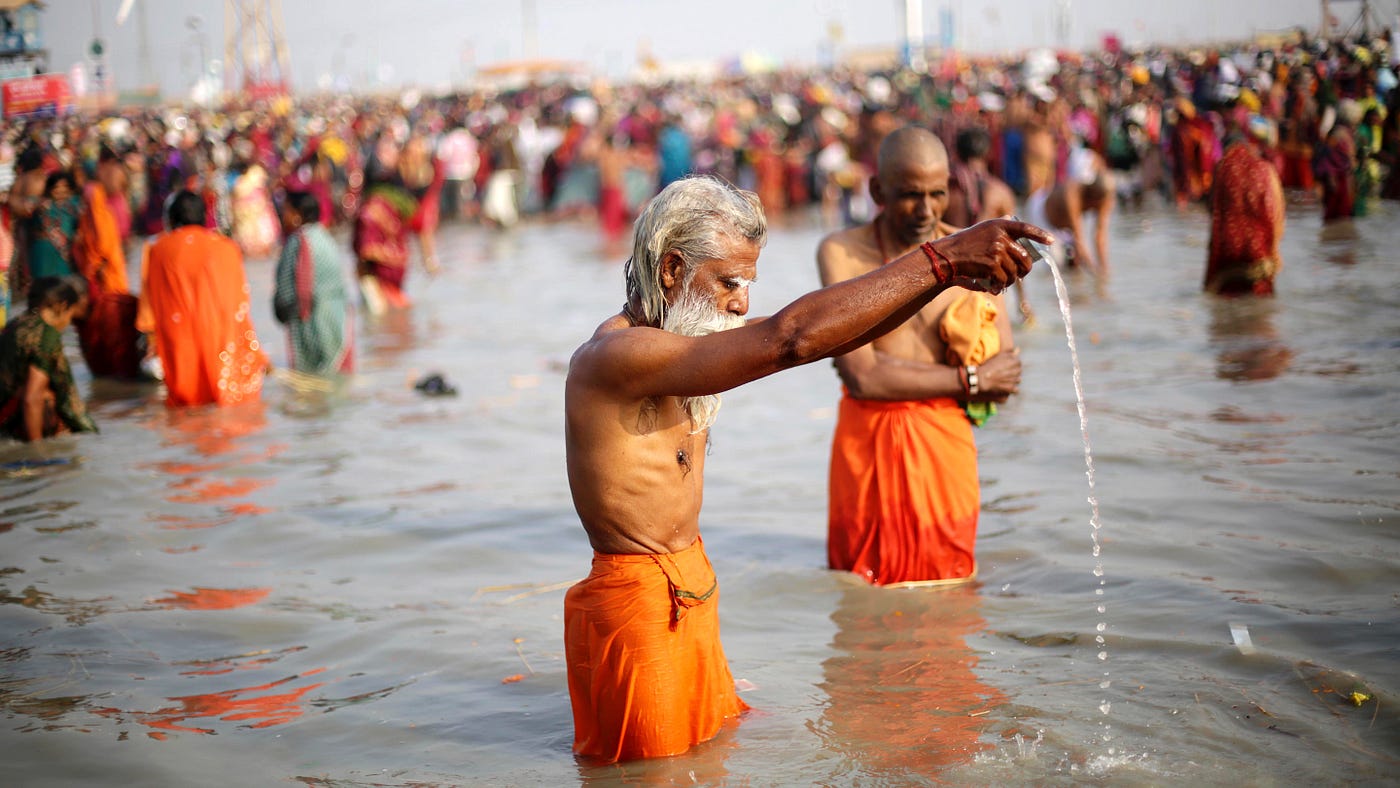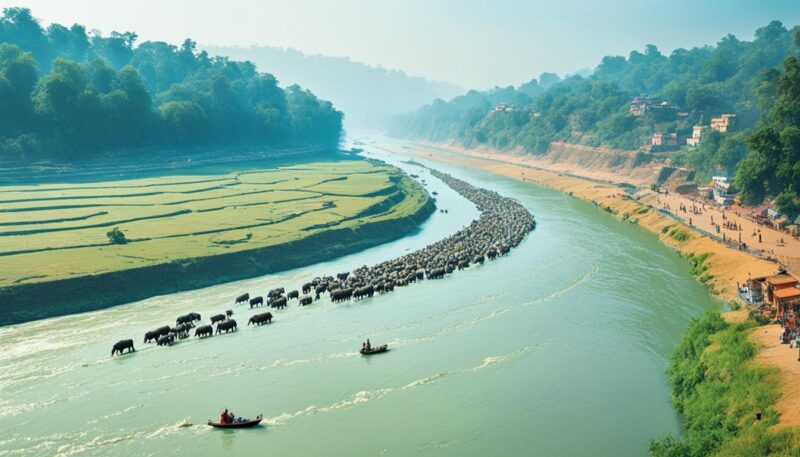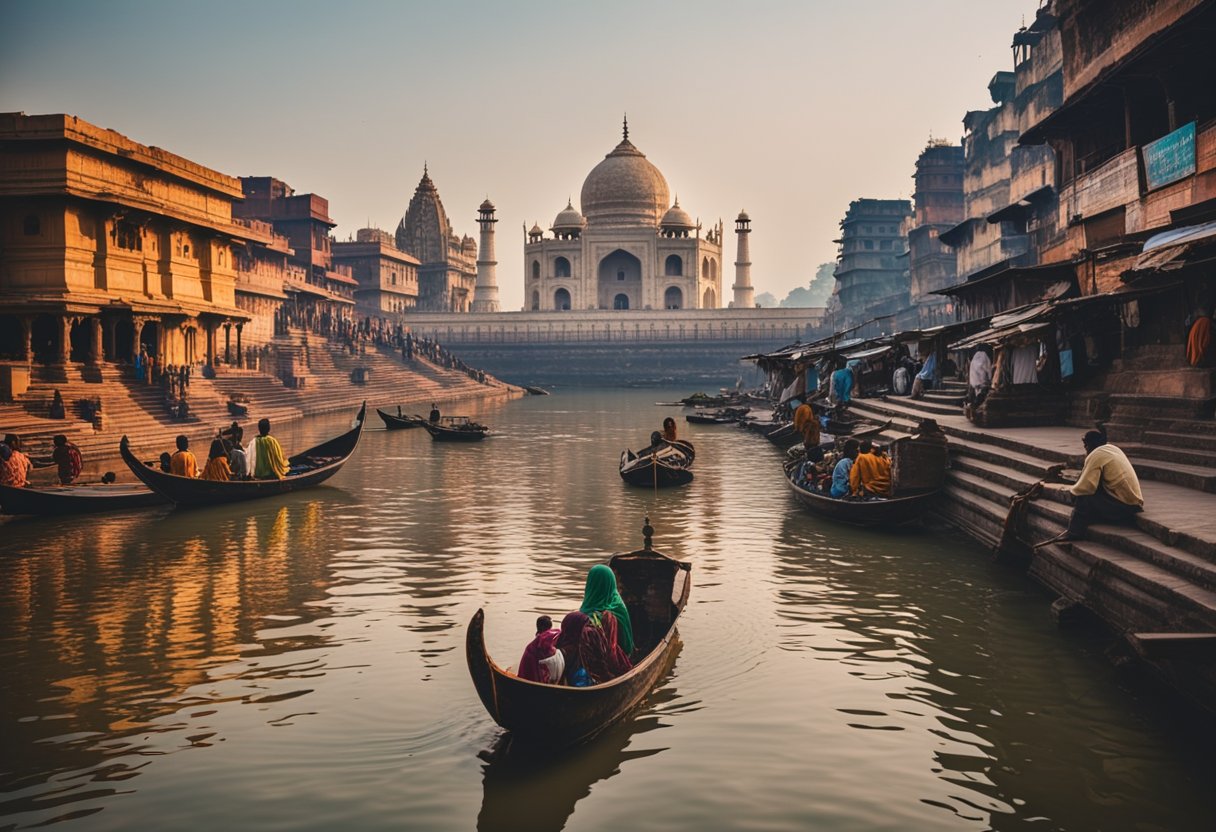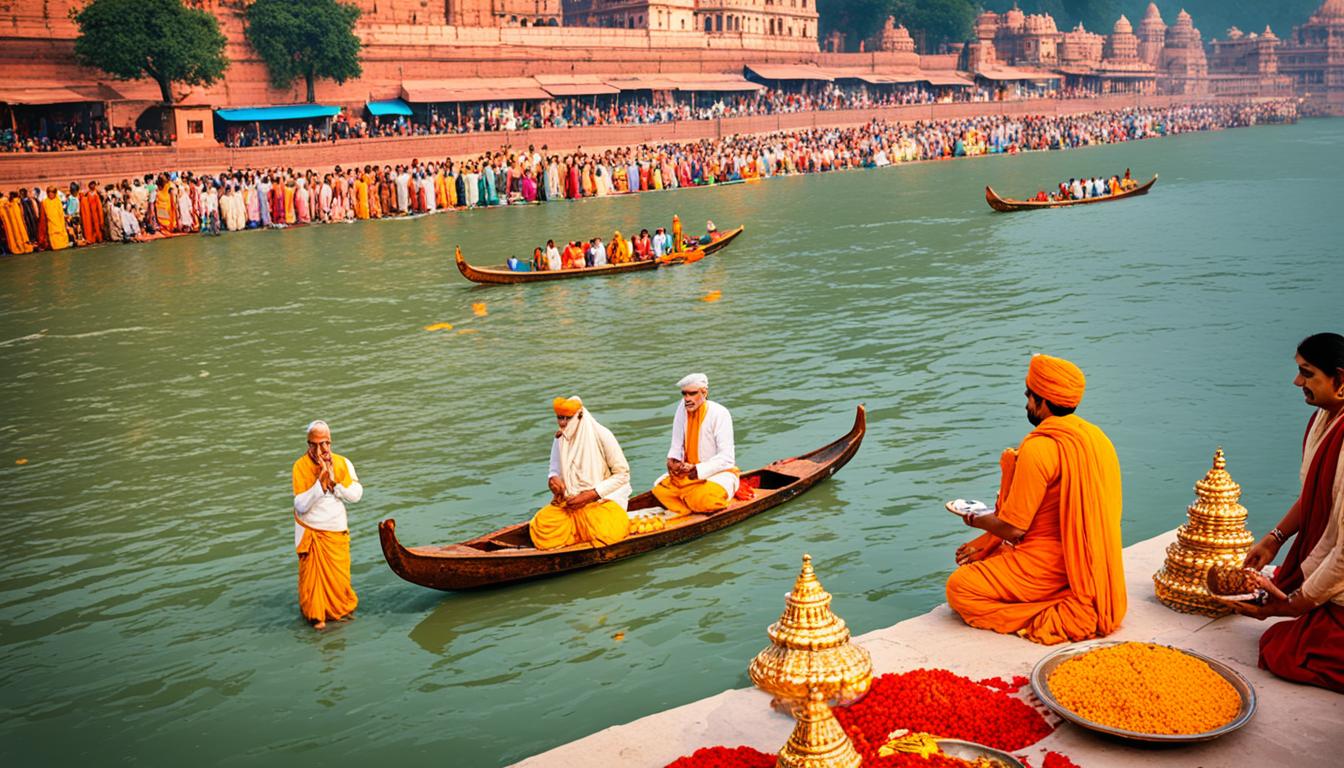Did you know more than 400 million people live in the Ganges River Basin? This is like the entire United States population!
Imagine a river giving life to millions and holding deep spiritual meaning. The Ganges River does exactly this. Starting in the Himalayas, it flows through northern India. Hindus have worshipped it as Mother Ganga for ages.
The Ganges is vital to India beyond just being a river; it’s a lifeline. It supports farming, jobs, and is a link to religious and cultural history. But now, it faces threats that could harm its value and the people who depend on it.
Key Takeaways:
- The Ganges River holds immense importance in India, with more than 400 million people living in its basin.
- It is considered sacred by Hindus and is worshipped as the Mother Ganga.
- The river provides freshwater for agriculture and supports the economy of India.
- However, pollution and climate change pose significant threats to the Ganges River and the people who rely on it.
- Preserving and protecting the Ganges is crucial to ensure its continued significance for future generations.
Cultural and Spiritual Significance

The Ganges River is pivotal in India’s culture and spiritual life. For many, it’s a sacred and divine symbol. People believe that taking a dip in its waters can cleanse away their sins and bring them closer to spiritual freedom. It’s a key part of religious ceremonies and is seen as a path to ultimate liberation, with people laying to rest their loved ones there.
Varanasi and Haridwar have become major spots for spiritual journeys, attracting numerous followers looking for inner peace. Varanasi, one of the world’s oldest cities, is special for Hindus. Here, people come to perform sacred rituals and pray at the river’s steps. Haridwar, near the Himalayas, marks where the Ganges enters the plains. It’s famous for the Kumbh Mela, a Hindu gathering every 12 years bringing countless people together for blessings and ceremonial baths.
The river’s value goes beyond religious aspects. It’s a central part of India’s deep-rooted history and creative culture. The Ganges inspires various art forms and music, reflecting its beauty and spirituality. It’s not just a river; it’s ingrained in India’s essence, attracting people with its charm and mystery.
The Power of Devotion: A Quote from a Devotee
“Bathing in the Ganges is more than just a physical act; it is a spiritual phenomenon. When I immerse myself in the sacred waters, I feel a profound connection to the divine energy that flows through every droplet. The Ganges is not just a river; it is a divine mother who nurtures and uplifts us.”
– A devout pilgrim who experiences the spiritual significance of the Ganges River.
The Ganges River: A Pilgrimage of the Soul

The journey along the Ganges River is transformative for those seeking spiritual growth. It allows believers to explore their spirituality through ancient rituals and celebrations. The river’s cultural and spiritual importance gives it a special significance, changing the lives of all who encounter its divine power.
Pilgrimage Cities Along the Banks of the Ganges River
- Varanasi: The spiritual capital of India, Varanasi is a melting pot of religious traditions and a hub for spiritual seekers.
- Haridwar: Known as the “Gateway to God,” Haridwar is a city of ancient temples and a magnet for those seeking salvation.
- Allahabad (Prayagraj): The confluence of three sacred rivers, Allahabad is the site of the revered Kumbh Mela festival.
- Rishikesh: Nestled in the foothills of the Himalayas, Rishikesh is renowned as the yoga capital of the world and a center for meditation.
| City | Notable Attractions |
|---|---|
| Varanasi | Kashi Vishwanath Temple, Dashashwamedh Ghat, Assi Ghat, Manikarnika Ghat |
| Haridwar | Har Ki Pauri, Mansa Devi Temple, Chandi Devi Temple, Ganga Aarti |
| Allahabad (Prayagraj) | Sangam (Confluence of Rivers), Allahabad Fort, Akshaya Vat, Kumbh Mela |
| Rishikesh | Lakshman Jhula, Ram Jhula, Parmarth Niketan, Beatles Ashram |
Environmental Importance and Challenges
The Ganges River is key to India’s environment. It brings nutrients to the land, aiding farming. The river’s rich soil has supported life for hundreds of years.
Yet, it faces major issues too. Water pollution from people and factories is a big problem. This makes the river dangerous for swimmers. The pollutants harm animals and impact people living nearby.
Climate change worsens the Ganges River’s problems. The Himalayan glaciers, its source, are melting fast. This reduces water levels and harms the millions who rely on it.
We must act to save the Ganges River. It’s important for our future. Steps like better waste management, eco-friendly practices, and education can help. They will save the river and those it supports.
Preserving the Ganges River is not just a matter of environmental conservation. It is a shared duty to save India’s heritage.

Environmental Challenges of the Ganges River
Let’s dive into why the Ganges faces environmental issues:
| Environmental Challenge | Impact |
|---|---|
| Pollution | Contaminates water, threatens aquatic life, and poses health risks for communities along the river banks |
| Climate Change | Results in decreased glacial ice, leading to reduced water flow and freshwater availability |
| Loss of Biodiversity | Disruption of the river’s ecosystem affects flora, fauna, and the delicate balance of the environment |
| Water Scarcity | Decreased water levels impact agriculture, livelihoods, and the overall socioeconomic well-being of the region |
Reversing these challenges takes a group effort. Everyone needs to join in, from the government to regular people. Together, through eco-friendly actions and awareness, we can heal the Ganges.
Economic Importance and Livelihoods

The Ganges River is critical to India’s economy. It provides water to 40% of the population. This meets the basic needs of millions. Its basin has fertile land that helps agricultural economies in India and Bangladesh.
Farmers use the river for irrigation. This helps grow crops and support their families. The river’s sediment makes the land more fertile for farming.
The Ganges also supports a strong fishing industry. Many fish live in its waters. This helps fishermen make a living.
Moreover, the Ganges is a popular spot for tourists. Cities like Varanasi and Rishikesh attract many visitors. People come to see the river’s beauty and explore its culture and spirituality.
Tourism brings in money and jobs. It helps the local economy grow. In summary, the Ganges is key for both the economy and the people’s way of life in India.
| Agriculture | Fishing | Tourism |
|---|---|---|
| Provides water for irrigation | Supports fishing industries along the river | Attracts tourists to cities like Varanasi and Rishikesh |
| Fertile soil enhances agricultural productivity | Source of income for fishermen | Generates revenue and employment opportunities |
| Crucial for the livelihoods of farmers |
Religious Tourism and Traditions
The Ganges River is very important to many people. It attracts visitors from all over the world. In cities like Varanasi, Haridwar, and Allahabad, there are many religious festivals. Tourists and faithful people come to see these.
One very special event is the Ganga Aarti. It happens every evening by the river’s edge. This event shows how much people love this river.
Many people visit the river’s steps to take a bath or see funeral ceremonies. These places are very famous and show India’s deep culture. People believe the river is very spiritual.
There are places on the riverbank where you can do yoga and meditation. It’s very peaceful there. The sound of the flowing water helps people relax and think deeply.
“The Ganges River is not just a physical entity; it is a conduit of spirituality, an embodiment of faith, and a source of purification for countless devotees.”
Adventure Tourism

The Ganges River is now a hotspot for adventure tourism, especially in Rishikesh. Its quick waters welcome travelers to enjoy exciting activities like river rafting and kayaking.
If you’re an adventure seeker, you’ll love the mix of thrilling water sports with the Ganges’ natural beauty. The river makes for a perfect backdrop for a memorable adventure.
But for those wanting something calmer, there are slow boat rides. These let tourists enjoy the beautiful views and experience the local culture along the river.
You can also read: North vs South India
The Ganges River Delta
The Ganges River Delta is the largest in the world, located where the Ganges River meets the Bay of Bengal. It’s very important to India, supporting many ecosystems and different kinds of life.
It’s a unique and ever-changing landscape. This area is vital for many plants and animals. It helps keep the region’s natural balance in check.
Due to its rich soil, the delta is a key area for India’s farming. The Ganges River brings soil down over time, making it great for growing crops. This agriculture is crucial for feeding people in India.
Ecosystems and Biodiversity
The delta is home to many different ecosystems. These allow for a wide range of plants and animals to live. Mangrove forests are critical here, providing homes for many species.
They help protect the coast from erosion and are important for marine life. The area’s wetlands also are vital. They are known internationally for providing food and shelter to migratory birds.
Sustaining Agriculture
The fertile soil of the delta is key for India’s farming. It supports the growth of crops like rice and jute, which many depend on for work. Rivers and canals provide much needed water for these crops.
This farm land helps ensure there’s enough food. Both in India and the local communities, it’s crucial for survival.
Environmental Challenges
But this area faces serious threats. Issues like sea levels rising and coastal erosion are putting ecosystems and people at risk. More needs to be done to protect the delta.
There’s also a problem with pollution. Industrial waste and sewage harm the area. Conservation and better farming methods are being used to fight these problems.
| Importance of the Ganges River Delta | Challenges Faced |
|---|---|
| Supports diverse ecosystems and biodiversity | Rising sea levels and coastal erosion |
| Vital agricultural area | Pollution from industrial waste and untreated sewage |
| Protects against coastal erosion | Climate change impacts |
| Provides habitat for migratory birds |
Conclusion
The Ganges River is very important for India, for many reasons. It’s sacred to millions and supports life in various ways. But it is in danger from pollution and climate change.
It’s vital that we work to protect this river for our future. This will help keep its worth for generations to come.
FAQ
Why is the Ganges River important?
The Ganges River, known as the Ganga, is critical in India. It’s sacred to Hindus. It provides water for millions and is key for farming and the economy.
What is the significance of the Ganges River?
The Ganges River is deeply meaningful to many. It’s called the Mother Ganga and is said to come from the heavens. Taking a bath in it is seen as a purification from sin.
Much of India’s culture and religious traditions are linked to the Ganges. It’s where people go to celebrate festivals and perform rituals.
What is the environmental importance of the Ganges River?
The Ganges is vital for India’s environment. The river’s rich soil feeds the land and supports farming. It’s home to diverse ecosystems.
But, the Ganges faces big problems like pollution and water level drops. Climate change is making these issues worse.
What is the economic importance of the Ganges River?
The Ganges River drives India’s economy. It gives water to 40% of the population. This supports farming and fisheries.
The river also boosts tourism. It attracts people who want to see its natural beauty and cultural sites.
What are the cultural and religious traditions associated with the Ganges River?
The Ganges River is at the heart of Indian culture and religion. Cities like Varanasi are sacred to many. People go there to celebrate and perform ceremonies.
Bathing in the river and scattering loved ones’ ashes in it are important customs. So is watching the Ganga Aarti, a daily ritual by the river.
What kind of adventure tourism is available at the Ganges River?
The Ganges, especially around Rishikesh, is now a spot for adventure lovers. You can try river rafting, kayaking, and body surfing. For a quieter experience, there are slow boat rides offering scenic views.
What is the significance of the Ganges River Delta?
The Ganges River Delta is the biggest in the world. It’s rich in biodiversity and is a major farming area. It plays a big role in India’s food production.
Why is the Ganges River significant?
The Ganges is a symbol of a lot for India. It’s deeply sacred, culturally rich, and economically vital. It faces threats like pollution and climate change, yet it remains central to the country’s identity.
